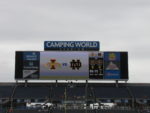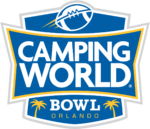The 2017 UCF Knights came into the fall football season with higher, yet still subdued expectations. The previous season, they jumped from 0-12 in 2015 to 6-7 in 2016. At the American Athletic Conference media days, the Knights were selected to finish second in the East Division. This was all part of UCF head coach Scott Frost’s plan. Like most coaching plans, it was really meant to be a three-year progression. In the first season, 2016, Frost had to adapt to the talent that was left from the old coaching regime.
Crossing those t’s and dotting those i’s…😬 pic.twitter.com/smWBp89cOB
— UCF Football (@UCF_Football) December 11, 2017
The 2015 roster had plenty of talent but suffered through major coaching woes. Armed with a combination of holdovers and new talent, the 2016 season was about bringing in a new philosophy, both on the field and in the stands. The terms UCFast and UCFierce were coined for the offense and defense. This helped spark fan interest and fired up the team. The 2016 spring game had over 20,000 fans, which would outdo many lower-level FBS programs.
After 2016 ended, Frost brought in a strong recruiting class to merge in with the remaining holdovers from the George O’Leary era and Frost’s first recruiting class. No one could have expected how far the UCF Knights would go in 2017.
The 2017 UCF Knights are armed with offense in mind. This is a squad built for scoring points quickly. At the center of the offense is sophomore McKenzie Milton, a quarterback from Hawaii who Frost found while still offensive coordinator at Oregon. Milton understood the type of offense Frost and offensive coordinator Troy Walters wanted to run and was able to help bring it to UCF. In his freshman year, Milton was inserted early into the starting lineup due to injury and had to learn the speed of the game. Milton was inconsistent his first year, but it gave him the experience and perspective to work on his game. Milton has a very short throwing motion, which has merits and flaws. One of the flaws was that he tended to push the ball high. During the offseason, he made strides to improve that.
Yo, Baker, we’re really happy for you…We’re gonna let you finish, but KZ had one of the best seasons of all time! pic.twitter.com/B0vEEITBwE
— UCF Football (@UCF_Football) December 10, 2017
The Knights came into 2017 loaded at running back. This is one of UCF’s younger positions as junior Taj McGowan was the only rotational player older than a sophomore. Along with McGowan, UCF had sensational sophomores Adrian Killins Jr and Jawon Hamilton. While Hamilton went down for the season with an early injury, the runnings backs didn’t miss a beat. Joining this group was an enigmatic RB/WR hybrid, freshman Otis Anderson, who played a major role as the season wore on. Hamilton was the original starter, but after his injury, Killins became the starting running back.
The wide receivers had to utilize the younger side of the roster. Led by upperclassmen Tre’Quan Smith and Jordan Akins, along with sophomore Drederick Snelson, this group scored a lot of points and very quickly as the trio combined for almost 2,200 yards and 24 touchdowns. The WR corps needed a lot of freshman help though. Stepping up were Gabriel Davis, Marlon Williams, and the aforementioned Otis Anderson. Anderson, who is listed as a receiver, finished 5th on the team in receiving and third in rushing. Frost and Walters lined up Anderson in multiple places due to his versatility.
The defense, coming into the season, had an outstanding front seven with lots of experience, but a new starting four in the defensive backfield. The defensive is led by senior Shaquem Griffin, the 2016 AAC defensive player of the year. Shaquem burst on the scene in 2016 as a one-handed wrecking crew. Griffin suffered from amniotic band syndrome before he was born and ultimately had his left hand amputated at age four. This didn’t stop him from becoming a very strong football player. Griffin’s success was a direct result of Frost moving him from the defensive backfield to linebacker.
Me and @shaquillg have spent Fridays & Saturdays ballin together. Can’t wait to do it on Sundays ✊🏾🙏🏾 #AgainstAllOdds #BuiltByUCF pic.twitter.com/0Os8oN2AHs
— shaquem griffin (@Shaquemgriffin) December 11, 2017
Also anchoring the front side of the defense were seniors Chequan Burkett, Tony Guerad, and Jamiyus Pittman, along with juniors Pat Jasinski, and Titus Davis. Between most of them, they had plenty of time on the field and in the game. The defensive backfield of Tre Neal, Mike Hughes, Kyle Gibson, Brandon Moore, and later Neville Clark had talent and speed but lacked starting experience. While UCF did snag 18 interceptions, a plus nine compared to their opponents, the defense gave up a lot of yards through the air as the season wore on.
UCF began the season with a Thursday night home game against Florida International. Last year, UCF blasted FIU 53-14 and continued to pummel the Panthers 61-17 to spoil the debut of FIU coach Butch Davis. Mother nature decided to derail the season with Hurricane Irma. With Irma hitting Florida, UCF had to call their home game against Memphis in Week 2. The following week, UCF was supposed to host Georgia Tech, but that game was called as well. UCF was hosting the National Guard and they were utilizing Spectrum Stadium. This hurt UCF’s ranking potential as the season wore on. Working with the AAC, a number of conference schools reworked their schedules so UCF and South Florida could still end up with a full eight game conference schedule. For UCF, this meant buying out of the September 30th game against Maine to reschedule the Memphis game.
While the season was unfolding, UCF sought to recoup a canceled home game and with the help of the NCAA, scheduled Austin Peay as their seventh game. This would give UCF 11 regular season games. This helped create goodwill with the fans, but took away UCF’s bye week. They would ultimately play 11 games in a row.
After three weeks, UCF finally played their second game of the season at Maryland. Avenging a double-overtime loss in 2016, UCF blew the game open in the second quarter en route to a 38-10 win. UCF then returned home for their makeup game against Memphis. The Tigers and Knights were both undefeated going into this contest, but UCF amassed over 600 yards of offense and ran past Memphis 40-13. With this win, UCF cracked the top 25 in both the AP and Coaches polls. The destinies of the Knights and the Tigers would play a role later.
After the rumble in Orlando, the Knights benefitted from a couple of soft games. The first was an away game at Cincinnati and then a home game against East Carolina. The Knights made short work of both of them, winning 51-23 and 63-21, respectively. What was interesting in the Cincinnati game was that a weather delay ended up in a called game after only three quarters. After dispatching ECU, UCF was 5-0 for the first time since joining Division I in 1990. The talk of an undefeated season started to quietly simmer.
Before UCF and the Knights fans could really get on board with the idea of running the table, they had to go to Annapolis and play Navy. Navy was riding a 17 game home winning streak and their triple-option offense is tough to play for. Scott Frost, when he was a college quarterback, played in an option system, so he worked as the scout QB. It ended up being the first game where UCF didn’t run away and create a blowout. While the game remained close, UCF never trailed and prevailed 31-21. After the hurricane, UCF had four games to watch out for: Memphis, Navy, SMU, and South Florida. At 6-0, the Knights had dispatched the first two, but SMU and South Florida awaited.
Join us next time as we recap the second half of the 2017 UCF football season.
Author Profile

-
I've been writing off and on since 2003, where I first wrote for Southern College Sports. After a hiatus, I returned in 2012 with The Sports Chronicles, a predecessor of NGSC Sports. After a brief stint with WBLZ in 2017, I came back to NGSC Sports and currently guest write on the site. Also, from 2015 to 2017, I helped run Off the Cuff, a sports program and blog with STLR Media.
I have done radio and podcasts dating back to 2006 with The Student of the Game, an NFL podcast. In 2012, I cohosted TSC Saturday Night on the Sports Chronicles and The OT With Andrew G on WTMY in Sarasota, FL. I later moved the OT to NGSC Sports until 2014 where I started The College Cram, also on NGSC Sports. After a brief hiatus, I returned to radio in 2015 with both Off the Cuff on STLR and The Mad Scientist Sports Lab on The Inscriber.
Latest entries
 BIG XIIDecember 28, 2019Notre Dame dominates 2019 Camping World Bowl 33-9
BIG XIIDecember 28, 2019Notre Dame dominates 2019 Camping World Bowl 33-9 BIG XIIDecember 24, 20192019 Camping World Bowl – Preview
BIG XIIDecember 24, 20192019 Camping World Bowl – Preview Featured ProspectsApril 14, 20182018 NFL Draft: Defensive Backs Round 1
Featured ProspectsApril 14, 20182018 NFL Draft: Defensive Backs Round 1 MLBFebruary 3, 2018Chief Wahoo to Head Down That Old Dusty Trail
MLBFebruary 3, 2018Chief Wahoo to Head Down That Old Dusty Trail

